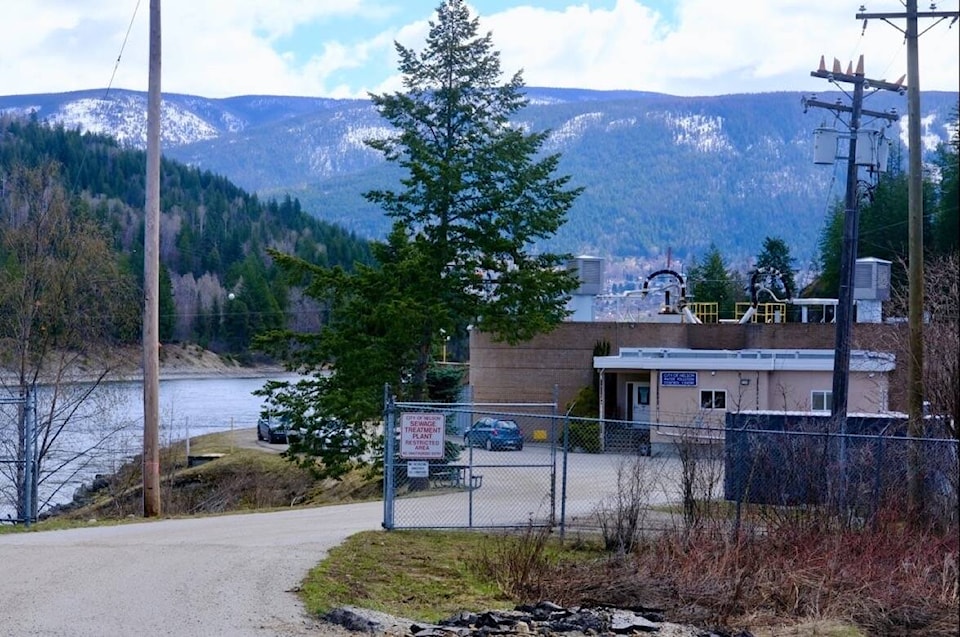Between 2017 and 2020, Nelson’s sewage treatment plant, on 15 separate occasions, accidentally released a combined total of more than 3,000 cubic metres of partially treated sewage into the Kootenay River, according to provincial government documents.
The sewage had received primary treatment (filtering and settling out of solids) but not the usual secondary treatment (remaining material broken down by bacteria and by ultraviolet light).
These incidents occurred during severe rainstorms. Many of Nelson’s storm sewers drain directly into the sewage plant, and in rainstorms the storm flow overwhelms the plant, bypassing and flowing around the sewage treatment process.
The city’s public works director Colin Innes says having storm water and sewage in the same pipe was considered acceptable when Nelson’s infrastructure was built in the 1960s. He says that currently some of the storm water flows directly in to the lake, as it should, but some of it is still connected beneath city streets, to the sewer system in unknown and unmapped locations. City crews separate them whenever they are discovered in the course of their work, and Innes says the goal over time is to have all storm water diverted directly to the lake and away from the sewage treatment plant.
The sewage treatment plant is located on the shore of Kootenay Lake near Grohman Narrows and releases its effluent into the Kootenay River after primary and secondary treatment.
The effluent looks clear, Innes says, but he wouldn’t drink it. To be drinkable it would have to undergo tertiary treatment – treatment by more advanced bacterial processes, which the plant is not capable of.
Other instances of sewage spills into the lake have stemmed from leaks in a large sewer pipe, known as the force main, that runs along the floor of the lake from the vicinity of the airport to the sewage plant. On several occasions, sewage plant operators have noticed a surprisingly low flow into the plant, and divers have discovered leaks in the force main that have resulted in unknown amounts of raw sewage released into the river. Innes says this has happened four times in the past five years.
On several occasions since 2017, the province ruled that the city was out of compliance with regulations because of data or test results that were not submitted or not monitored often enough, including data related to fecal coliform, total suspended solids, biological oxygen demand, turbidity, and ultraviolet light transmittance.
On 203 occasions between 2017 and 2020, the amount of material flowing through the system has exceeded the plant’s legal volume limit, although those excesses did not release untreated sewage into the river.
These various releases of effluent and incomplete data are documented in a series of six warning letters and non-compliance letters to the city dated between 2018 and 2021 from regulators at the Ministry of the Environment and Climate Change Strategy. These documents can be searched for at .
The city has never been penalized for any of these compliance problems.
Innes says none of the warning letters come out of the blue, and that his staff are in regular dialogue with regulators.
“We get the inspectors coming through, and we do have really good talks with them. We certainly show them everything that they want to see. If you just read these letters on the surface, it would seem like maybe we’re in a tenuous relationship. I don’t believe that to be the case.”
Innes says the plant is not designed for some of the things the city’s provincial sewage permit requires, which causes some technical problems with compliance.
Another issue is an increase, over the past few years, of an unusually concentrated effluent arriving at the plant from the city, the result, Innes says, of the increased number of breweries and restaurants in the city. It takes longer for the plant to break this organic material down, leading to some of the regulatory problems.
“Any place that does food prep is a source of a high-strength effluent,” Innes says, “just because there’s so much nutrients that that winds up in the water. And so any organic loading of any kind is going to present a challenge.”
An additional issue is FOG materials – fat, oil, and grit – that build up and clog pumps and pipes and has to be vacuumed out and disposed of. The city has been dumping this material for several years at a site separate from the treatment plant and on Sept. 1, 2021, received a letter from the province prohibiting this disposal. Innes said the city has since had to hire a contractor to take this FOG material to the landfill.
Nelson’s sewage plant and infrastructure was constructed in 1968, with some upgrades since.
“We’ve got an older plant that’s worked for a long time here and really done a lot of heavy lifting for the city,” Innes says. “We’re pretty much at the outside edge of what it’s able to handle.”
In the next few years Nelson will spend millions of dollars upgrading or replacing the plant, and expects to get most of that money as grants from senior governments. The consultant Urban Systems is already working on research and monitoring for the project, developing a master plan for the city’s sewage.
The need for improved system is made more urgent by climate change, Innes says.
“This is something we really need to tackle,” Innes says. “We need a plant that’s going to be able to handle … projected impacts of climate change. From what I understand, we’re going to be seeing more intense rainfall events.”
bill.metcalfe@nelsonstar.com
Like us on and follow us on




